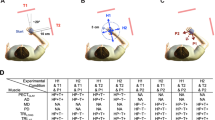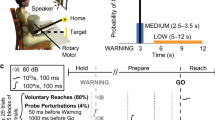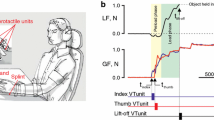Abstract.
It is known that proprioceptive feedback induces muscle activation when the facilitation of appropriate motoneurons exceeds their threshold. In the suprathreshold range, the muscle-reflex system produces torques depending on the position and velocity of the joint segment(s) that the muscle spans. The static component of the torque-position relationship is referred to as the invariant characteristic (IC). According to the equilibrium-point (EP) hypothesis, control systems produce movements by changing the activation thresholds and thus shifting the IC of the appropriate muscles in joint space. This control process upsets the balance between muscle and external torques at the initial limb configuration and, to regain the balance, the limb is forced to establish a new configuration or, if the movement is prevented, a new level of static torques. Taken together, the joint angles and the muscle torques generated at an equilibrium configuration define a single variable called the EP. Thus by shifting the IC, control systems reset the EP. Muscle activation and movement emerge following the EP resetting because of the natural physical tendency of the system to reach equilibrium. Empirical and simulation studies support the notion that the control IC shifts and the resulting EP shifts underlying fast point-to-point arm movements are gradual rather than step-like. However, controversies exist about the duration of these shifts. Some studies suggest that the IC shifts cease with the movement offset. Other studies propose that the IC shifts end early in comparison to the movement duration (approximately, at peak velocity). The purpose of this study was to evaluate the duration of the IC shifts underlying fast point-to-point arm movements. Subjects made fast (hand peak velocity about 1.3 m/s) planar arm movements toward different targets while grasping a handle. Hand forces applied to the handle and shoulder/elbow torques were, respectively, measured from a force sensor placed on the handle, or computed with equations of motion. In some trials, an electromagnetic brake prevented movements. In such movements, the hand force and joint torques reached a steady state after a time that was much smaller than the movement duration in unobstructed movements and was approximately equal to the time to peak velocity (mean difference <80 ms). In an additional experiment, subjects were instructed to rapidly initiate corrections of the pushing force in response to movement arrest. They were able to initiate such corrections only when the joint torques and the pushing force had practically reached a steady state. The latency of correction onset was, however, smaller than the duration of unobstructed movements. We concluded that during the time at which the steady state torques were reached, the control pattern of IC shifts remained the same despite the movement block. Thereby the duration of these shifts did not exceed the time of reaching the steady state torques. Our findings are consistent with the hypothesis that, in unobstructed movements, the IC shifts and resulting shifts in the EP end approximately at peak velocity. In other words, during the latter part of the movement, the control signals responsible for the equilibrium shift remained constant, and the movement was driven by the arm inertial, viscous and elastic forces produced by the muscle-reflex system. Fast movements may thus be completed without continuous control guidance. As a consequence, central corrections and sequential commands may be issued rapidly, without waiting for the end of kinematic responses to each command, which may be important for many motor behaviours including typing, piano playing and speech. Our study also illustrates that the timing of the control signals may be substantially different from that of the resulting motor output and that the same control pattern may produce different motor outputs depending on external conditions.
Similar content being viewed by others
Author information
Authors and Affiliations
Additional information
Electronic Publication
Rights and permissions
About this article
Cite this article
Ghafouri, M., Feldman, A. The timing of control signals underlying fast point-to-point arm movements. Exp Brain Res 137, 411–423 (2001). https://doi.org/10.1007/s002210000643
Received:
Accepted:
Issue Date:
DOI: https://doi.org/10.1007/s002210000643




